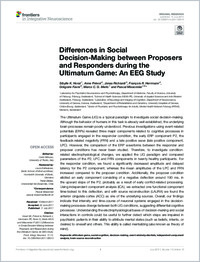Differences in social decision-making between proposers and responders during the ultimatum game: an eeg study
- Horat, Sibylle K. Laboratory for Psychiatric Neuroscience and Psychotherapy, Department of Medicine, Faculty of Science, University of Fribourg, Switzerland
- Prévot, Anne School of Health Sciences (HEdS-FR), University of Applied Sciences and Arts Western Switzerland, Switzerland
- Richiardi, Jonas Laboratory of Neurology and Imaging of Cognition, Department of Neuroscience, University of Geneva, Switzerland
- Herrmann, François R. Department of Rehabilitation and Geriatrics, University Hospitals of Geneva, Chêne-Bourg, Switzerland
- Favre, Grégoire Sector of Psychiatry and Psychotherapy for Adults, Mental Health Network Fribourg (RFSM), Marsens, Switzerland
- Merlo, Marco C. G. Laboratory for Psychiatric Neuroscience and Psychotherapy, Department of Medicine, Faculty of Science, University of Fribourg, Switzerland
- Missonnier, Pascal Laboratory for Psychiatric Neuroscience and Psychotherapy, Department of Medicine, Faculty of Science, University of Fribourg, Switzerland - Sector of Psychiatry and Psychotherapy for Adults, Mental Health Network Fribourg (RFSM), Marsens, Switzerland
-
11.07.2017
Published in:
- Frontiers in Integrative Neuroscience. - 2017, vol. 11, p. 13
English
The Ultimatum Game (UG) is a typical paradigm to investigate social decision-making. Although the behavior of humans in this task is already well established, the underlying brain processes remain poorly understood. Previous investigations using event-related potentials (ERPs) revealed three major components related to cognitive processes in participants engaged in the responder condition, the early ERP component P2, the feedback-related negativity (FRN) and a late positive wave (late positive component, LPC). However, the comparison of the ERP waveforms between the responder and proposer conditions has never been studied. Therefore, to investigate condition-related electrophysiological changes, we applied the UG paradigm and compared parameters of the P2, LPC and FRN components in twenty healthy participants. For the responder condition, we found a significantly decreased amplitude and delayed latency for the P2 component, whereas the mean amplitudes of the LPC and FRN increased compared to the proposer condition. Additionally, the proposer condition elicited an early component consisting of a negative deflection around 190 ms, in the upward slope of the P2, probably as a result of early conflict-related processing. Using independent component analysis (ICA), we extracted one functional component time-locked to this deflection, and with source reconstruction (LAURA) we found the anterior cingulate cortex (ACC) as one of the underlying sources. Overall, our findings indicate that intensity and time-course of neuronal systems engaged in the decision-making processes diverge between both UG conditions, suggesting differential cognitive processes. Understanding the electrophysiological bases of decision-making and social interactions in controls could be useful to further detect which steps are impaired in psychiatric patients in their ability to attribute mental states (such as beliefs, intents, or desires) to oneself and others. This ability is called mentalizing (also known as theory of mind).
- Faculty
- Faculté des sciences et de médecine
- Department
- Médecine 3ème année
- Language
-
- English
- Classification
- Biological sciences
- License
-
License undefined
- Identifiers
-
- RERO DOC 305101
- DOI 10.3389/fnint.2017.00013
- Persistent URL
- https://folia.unifr.ch/unifr/documents/305954
Statistics
Document views: 106
File downloads:
- pdf: 185
